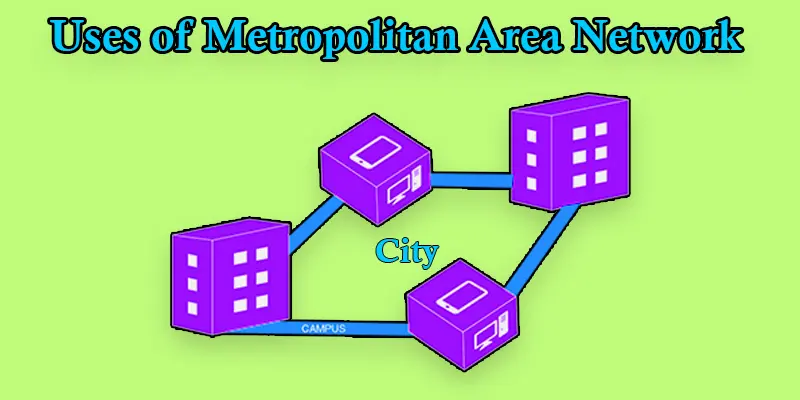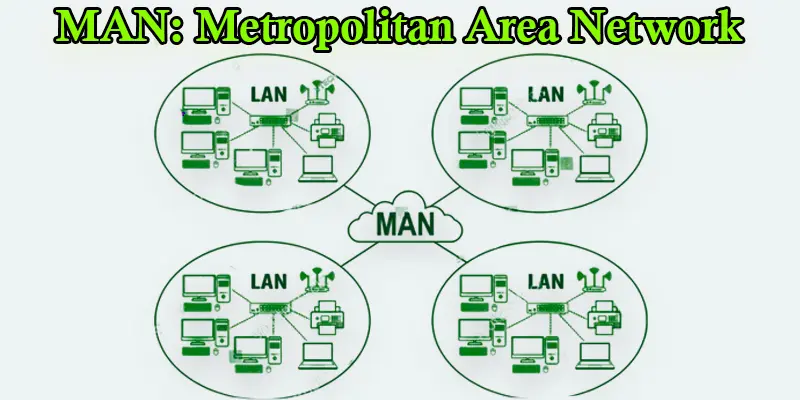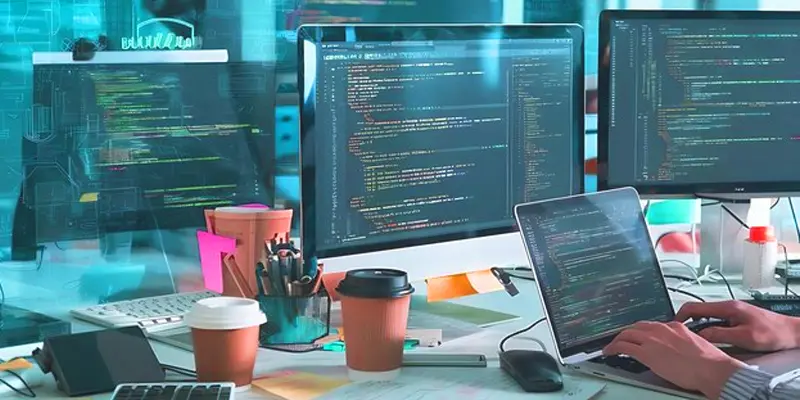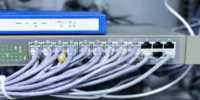MAN Full Form in Computer Networking | History, Uses, Advantages and Disadvantages
Published: 24 Aug 2024
A Metropolitan Area Network (MAN) | What is it?
A system that connects many networks inside a city or a large campus, like a business park or university, is called a metropolitan area network (MAN). It helps different buildings and locations share data quickly and smoothly. Think of it as a network that spans a whole city, allowing computers and devices to communicate with each other more effectively than if they were just on a local network. This makes it easier for people and organizations to exchange information across a larger area without needing a wider network that covers the entire country.
| How do MANs work? |
|---|
|
What are the uses of the MAN network?
- 1. Connecting Offices: It links multiple office buildings in a city, making it easy for employees to share files and communicate.
- 2. City-Wide Internet Access: MAN provides high-speed internet throughout the city so residents and businesses can quickly access online services.
- 3. Educational Institutions: Schools and universities use MAN to connect different campuses, allowing students and staff to access shared resources and information.
- 4. Public Services: City services like libraries and government offices use MAN to streamline operations and share data efficiently.
- 5. Business Networks: Companies with multiple locations in a city use MAN to connect their branches, making it easier to manage operations and data.
- 6. Telecommunications: MAN supports telecom services by connecting various network components across a city for better communication and service delivery.
- 7. Data Centers: It links data centres within a city, allowing them to communicate and share data quickly, which is important for cloud services and data storage.

Why do we use MAN?
- City-Wide Connectivity: It links different networks across a city, allowing various locations to share data and resources efficiently.
- High-Speed Data Transfer: MAN provides faster data transfer rates than local networks, making communication quicker.
- Cost-Effective Networking: It can be more affordable than setting up separate networks for each location within a city.
- Improved Communication: It helps businesses and organizations communicate easily across multiple sites.
- Scalability: MANs are flexible and can be expanded to include more locations or increase bandwidth.
Characteristics of MAN
- City-Wide Coverage: MAN spans a large area within a city, connecting various networks and locations over a wider region than a local network.
- High-Speed Connections: It uses fast technology, such as fiber optics, to ensure quick data transfer between different sites within the city.
- Centralized Management: MAN is often managed from a central point, making it easier to oversee and maintain the network across the city.
- Scalable: It can be expanded to include more locations or handle more data as the city grows or needs change.
- Reliable Performance: Designed to handle a lot of data traffic efficiently, ensuring stable and consistent connectivity for users across the city.
History of MAN
- Early Days: In the 1970s and 1980s, people started developing ways to connect multiple local area networks (LANs) within a city. This idea led to the creation of MANs to improve communication across larger areas.
- First MANs: By the 1990s, technology like fiber optics and high-speed cables became available, making it possible to build MANs that could handle more data and connect more locations within a city.
- Growth of the Internet: As the Internet became more popular in the late 1990s and early 2000s, cities started using MANs to provide better Internet access and connect businesses, schools, and other organizations.
- Modern MANs: Today, MANs use advanced technologies to offer fast and reliable connections across cities. They support a wide range of services, from internet access to linking different branches of companies and public services.
- Future Trends: As technology advances, MANs become more efficient and capable, supporting new applications and services to meet cities’ growing needs.
| What are the advantages of the Metropolitan Area Network? |
|---|
|
| What are the disadvantages of the Metropolitan Area Network? |
|---|
|
How are MAN networks constructed and maintained?
Metropolitan Area Networks (MANs) are constructed by installing high-speed data connections like fiber optics or leased lines across a city. These connections link various local networks, buildings, and facilities to create a unified network. Regular monitoring and management are required to maintain a MAN to ensure smooth operation and address any issues. This involves updating equipment, troubleshooting problems, and ensuring security to keep the network reliable and efficient.

Process of MAN Network Constructed
- Planning: Identify the locations to be connected, determine the network’s scope, and design the network layout.
- Infrastructure Setup: Install the necessary physical components, such as fiber optic cables, routers, and switches, throughout the city or large campus.
- Connection: The installed infrastructure links various local area networks (LANs) and facilities to the central network.
- Configuration: Set up and configure network devices to ensure they work together efficiently and securely.
- Testing: Thoroughly test the network’s performance, reliability, and security before it goes live.
- Deployment: Launch the network and start providing services to users.
- Maintenance: Regularly monitor and maintain the network to address issues, update equipment, and ensure continued performance.
Metropolitan Area Network for Organization
Metropolitan Area Networks (MANs) for organizations help connect multiple office locations, buildings, or campuses within a city. This setup allows businesses to efficiently share data, resources, and communication tools across their sites. Organizations can improve collaboration, streamline operations, and ensure fast, reliable access to important information by using a MAN. It’s like having a supercharged local network that covers a larger area, making it easier for all parts of the organization to stay connected and work together smoothly.
Additional Information on MAN Network
- Not for Long Distances: MANs are great for connecting places within a city but aren’t used for long distances. Other types of networks, such as wide area networks (WANs), are utilized for larger areas, such as connecting multiple cities or nations.
- Shared Resources: With a MAN, different locations can share resources like printers, servers, and internet connections, which helps save costs and improve efficiency.
- Flexibility: MANs can be designed to handle different types of data traffic, such as internet browsing, video conferencing, or transferring large files.
- Private and Public Options: MANs can be private, used only by a specific organization or public, and are available to multiple users and organizations within the city.
Difference between MAN vs CAN
1. Full Form
- MAN: Metropolitan Area Network is what MAN stands for.
- CAN: Campus Area Network is what it stands for.
2. Coverage Area
- MAN: Covers a large area within a city, connecting multiple buildings or locations.
- CAN: Covers a smaller, specific area like a university campus, a business park, or a company’s multiple buildings.
3. Size
- MAN: Spans a city or large region, providing city-wide connectivity.
- CAN: Limited to a single campus or close-knit area, providing local connectivity.
4. Purpose
- MAN: Used to connect different organizations, offices, or institutions within a city.
- CAN: Used to connect buildings or facilities within a specific campus or site, often for a single organization.
5. Infrastructure
- MAN: Requires extensive infrastructure like fiber optics or high-speed connections over longer distances.
- CAN: Typically uses simpler infrastructure within a smaller area, often connected by local cables or wireless connections.
6. Examples
- MAN: City-wide internet services, connecting multiple company branches across a city.
- CAN: Connecting buildings within a university campus or a business park’s offices and facilities.

Conclusion About (MAN) Metropolitan Area Network
A metropolitan area network connects multiple cities or large campus locations. It provides fast and efficient data transfer, allowing organizations and businesses to share resources and communicate effectively. While MANs come with some challenges, like high initial costs and maintenance needs, their benefits, such as wide coverage and improved connectivity, make them a valuable solution for city-wide networking. Overall, MANs are crucial in enhancing communication and collaboration across urban areas.
FAQS (Frequently Asked Questions) Metropolitan Area Network in computer networking
A metropolitan area network links several local area networks (LANs) together throughout a big campus or city, facilitating quick and easy communication and data transmission within that region.
A Metropolitan Area Network (MAN) in computer networks offers connectivity throughout a metropolitan area, such as a city, allowing devices and computers to effectively share resources and communicate over a larger area than a local area network (LAN).
Examples of Metropolitan Area Networks include city-wide internet services, networks connecting different company branches within a city, and university networks linking multiple campus buildings across a city.

- Be Respectful
- Stay Relevant
- Stay Positive
- True Feedback
- Encourage Discussion
- Avoid Spamming
- No Fake News
- Don't Copy-Paste
- No Personal Attacks

- Be Respectful
- Stay Relevant
- Stay Positive
- True Feedback
- Encourage Discussion
- Avoid Spamming
- No Fake News
- Don't Copy-Paste
- No Personal Attacks





